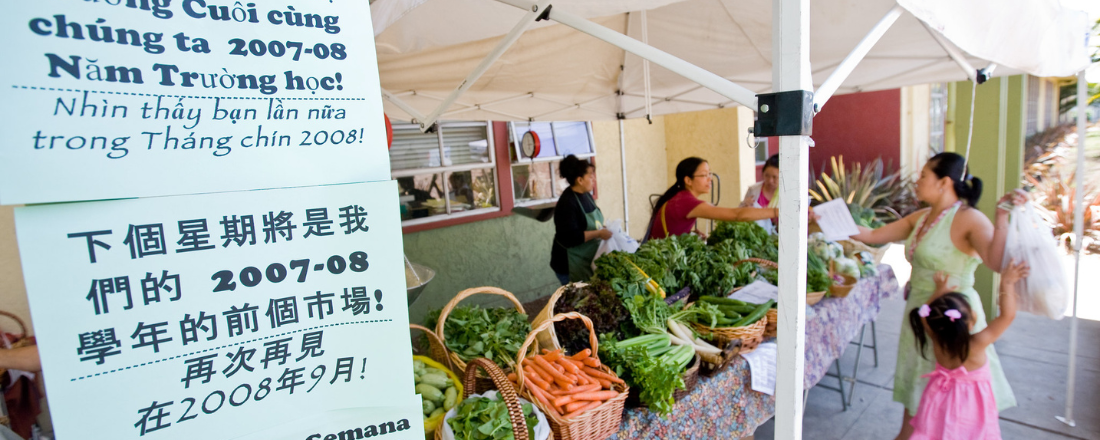
In the News
In California, Where Food is Abundant, Millions are Struggling to Put Food on Their Table
- CalMatters
-
Focus Areas
Chronic Disease Prevention, Healthy Communities -
Issues
Nutrition & Food Security -
Expertise
Health Education & Promotion, Public Policy Advocacy -
Programs
Center for Wellness and Nutrition, Roots of Change

“California is full of food, yet scarred with hunger.
Despite the state producing nearly half the country’s fruits and vegetables, one in five Californians are food insecure, meaning they have limited or uncertain access to adequate food. Food insecurity does not necessarily cause hunger, but hunger is a possible outcome.
People experience food insecurity in different ways. Some families may only eat lesser quality food, while others may simply eat less.
Food insecurity can have long-term physical and mental health effects. Research shows that food-insecure children can experience developmental delays and have trouble learning language. Children also are more likely to fall sick, recover more slowly, and be hospitalized more often if their access to food is inconsistent, according to the American Academy of Pediatrics. Food-insecure adults face higher rates of obesity, chronic illness, anxiety and depression.
The COVID-19 pandemic brought sharper awareness to hunger in California, as many Americans experienced food insecurity for the first time. In the last year record inflation drove food prices up 4.5%. Then in April, an influx of federal food aid from the pandemic dried up. The state has tried to take advantage of federal programs that provide food aid and expand the pool of who is eligible for help. Still, some warn that the number of food-insecure Californians will rise far beyond 20% in 2023.
What solutions are being tried?
California will begin a test next year in select counties that increases the minimum monthly CalFresh benefit from $23 to $50 per household and that supporters hope will go statewide with a higher amount.
In addition to a longstanding nutrition program for expecting mothers or moms with young children and a universal school meals program, lawmakers are continuing to expand California’s nutrition safety net. The California Nutrition Incentive Program runs a variety of programs to help CalFresh recipients buy healthy food. At 270 farmers’ markets across the state, food aid recipients get as much as $10 in matching money — meaning they have at least $20 to spend every week on fresh fruits and vegetables.
Policymakers recognize that CalFresh recipients predominantly shop at big-box stores and supermarkets. So the state recently funded a pilot, based on a model pioneered by Massachusetts, that allows recipients to get money rebated directly back on their EBT cards after buying fruits and vegetables at authorized grocery stores. Gov. Gavin Newsom just signed into law a bill for the state to seek federal waivers so that recipients can buy hot and prepared foods.
Challenges of scale, funding and inclusiveness still remain for California’s food aid programs. Continuing budget deficits could mean a shrinking of resources available to documented and undocumented food insecure Californians. With future budget surpluses, however, policymakers will be able to expand existing programs and consider new, research-based programs to end hunger in the state.
What else could be done?
- Increase public funding to food banks, to buy more from small farmers and distribute the produce to all.“Funding for local procurement at food banks gets at all of the bottom lines by keeping small, local farms in business, and by growing fresh, healthy food for people who need it and who don’t have to qualify for it.”—Catherine Brinkley, faculty director of the UC Davis Center for Regional Change
- Expand access to undocumented: Beginning in 2025, California will be the first state to issue food stamps to undocumented immigrants who are 55 and older. Advocates are calling for this policy to be expanded to all of California’s 2.3 million undocumented people and beyond to drastically reduce hunger in the state.“We’re talking about undocumented people, DACA recipients, temporary protected status immigrants, and some visa holders.”—Betzabel Estudillo, head of the Food4All campaign by advocacy group Nourish California
- Provide produce prescriptions: Imagine going to the doctor, who gives you a prescription to buy fresh fruits and veggies, and then getting reimbursed by your insurance provider. “Produce prescriptions” are already being tried in Stockton and Los Angeles, and advocates are calling for its large-scale expansion.

By 2040…we can create a system that has the capacity to feed every Californian well.Michael Dimock, MA
Program Director, Roots of Change, Public Health Institute
To read the full article, click on the link below.
Originally published by CalMatters
More Updates
Work With Us
You change the world. We do the rest. Explore fiscal sponsorship at PHI.
Support Us
Together, we can accelerate our response to public health’s most critical issues.
Find Employment
Begin your career at the Public Health Institute.



